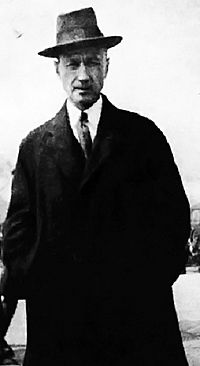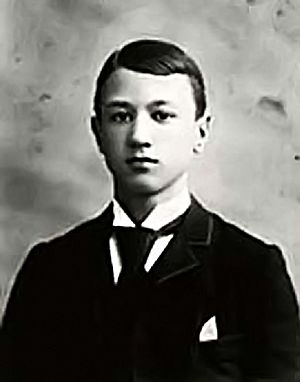Charles Ives facts for kids
Quick facts for kids
Charles Ives
|
|
|---|---|

Charles Ives around the year 1913
|
|
| Born |
Charles Edward Ives
30 October 1874 |
| Died | 19 May 1954 |
Charles Edward Ives (October 30, 1874 – May 19, 1954) was an American composer. He tried out new ways of making music. Many people didn't understand his music at first, but his ideas became popular later on.
He used sounds that sometimes seemed a bit 'harsh' or unusual. He also tried playing in several musical keys at once (polytonality). He used many rhythms at the same time (polyrhythms). He also mixed different musical textures. Not many people listened to his music when he first wrote it. Only much later did musicians realize how important his work was. Ives earned his living by selling insurance. He composed music in his free time.
Contents
Charles Ives' Life Story
Growing Up and Early Music
Charles Ives was born in Danbury, Connecticut. His father, George Ives, was a U.S. Army bandleader during the American Civil War. Charles's mother was a singer. His father taught him a lot about music. He also encouraged Charles to try out new sounds.
His father taught him counterpoint and the music of J.S. Bach. He also trained Charles's musical ear. He would have Charles sing a tune in one key. At the same time, he would play the accompaniment in another key. This helped young Charles get used to modern sounds. These sounds were very different from traditional Romantic music.
Charles also listened to his father's marching band in Danbury town square. Sometimes, other bands played on different sides of the square. This meant he heard several pieces of music at the same time. His father also taught him the music of Stephen Foster.
Ives became a church organist when he was 14 years old. He wrote many hymns and songs for church services. One famous piece was his Variations on 'America'. At the same time, he loved sports. He was good at baseball, football, and tennis.
College Years at Yale
Ives spent four years studying at Yale University. His teacher, Horatio Parker, was very good. He taught Charles important basic ways of composing. However, Parker sometimes didn't understand the new things Ives was writing. Ives got annoyed when his teacher said he couldn't end a piece of music on a 'harsh' sounding chord. But Ives liked it that way.
The choirmaster at the Centre Church, John Griggs, understood Ives's ideas better. It was a very sad time for Charles when his father died on 4 November 1894. He always admired his father greatly. His father had always encouraged his musical experiments. Charles kept busy composing. He did not play sports at Yale. His father had told him not to, so he would focus on his studies.
By the time Charles graduated, he had composed many pieces. These included over 40 songs, several marches, overtures, anthems, and organ pieces. He also wrote a string quartet and a symphony. However, most people knew him for a simple waltz tune called The Bells of Yale.
Adult Life and Composing
After Yale, Ives continued to work as a church organist. He also started working for an insurance company. He was very good at his job. He became well-known in the insurance business. Some of his business friends were often surprised to learn he was also a composer.
In 1907, Ives had his first health problem. After he felt better, he composed more than ever before. He got married in 1908. After more health issues in 1918, he composed very little. He stopped composing completely in 1926. His health problems continued. He retired from the insurance business in 1930. He spent some time fixing older works he had written. But he never wrote any new pieces.
Ives died in 1954 in New York City.
Charles Ives' Music Style
Ives published over 100 of his songs. He was a very good pianist. The piano parts in his music are often quite difficult. They include bitonality (using two keys at once) and pantonality (using all keys at once).
Even though he is now best known for his orchestra music, he also wrote two string quartets and other chamber music.
Famous Pieces
His organ piece Variations on "America" (1891) uses the tune My Country, 'Tis of Thee. This is the same tune as God Save the Queen. He changes the tune in several fun ways. He uses a march, a ragtime, and bitonality. This piece was not published until 1949. The variations are very different. They include a fast running line, close harmonies, a march, a polonaise, and a ragtime section. The parts in between are some of the first uses of bitonality.
His Symphony Number 1 was quite traditional. But Symphony Number 2 sounds much more modern. It even ends with a 'harsh' sounding chord with 11 notes.
In 1902, he stopped working as an organist. He left his best anthems and organ music in the church library. Sadly, these were thrown out in 1915 when the church moved. So, most of them are lost.
Central Park in the Dark is a piece for orchestra. It describes the quiet, mysterious park. Then you hear sounds of music from nearby nightclubs in Manhattan. These sounds include popular music of the day, ragtime, and even parts of Sousa's Washington Post March.
Perhaps the piece heard most often today is the short fanfare The Unanswered Question (1908). It is written for a very unusual group of instruments. These are a trumpet, four flutes, and a string orchestra. The strings play very slow, chorale-like music from behind the stage. Several times, the trumpet plays a short group of notes from behind the audience. Ives called these notes "the eternal question of existence". Each time, the trumpet is answered by loud, 'harsh' sounds from the flutes (onstage). But the last time, there is no answer. That is the question that is left unanswered. Musicians often discuss what the real meaning of this piece is.
Another well-known orchestra work is Three Places in New England. His most famous piano work is his Concord Sonata. Ives often liked to use parts of other pieces in his music. In this piano sonata, he uses the famous beginning of Beethoven's Fifth Symphony. It also has an interesting example of one of Ives's experiments. In the second part, he tells the pianist to use a 14¾ inch (37.5 cm) piece of wood. This is to make a thick but soft cluster chord (many notes played at once). The sonata is considered one of the best piano works of the 20th century.
One of his most interesting works is his Fourth Symphony (1910–16). It is written for a very large orchestra. The last movement is like a fight between 'harsh' sounds and traditional music. The piece ends quietly with only the percussion playing from a distance. This symphony seems to show everything Ives had been trying to do in music. It was not until 1965 that the complete symphony was performed.
Ives's music slowly started to become well known in the 1930s and 1940s. Schoenberg recognized how important he was. In 1951, Leonard Bernstein led the first performance of Ives's Second Symphony. This was a broadcast concert by the New York Philharmonic Orchestra. Bernstein recorded a lot of Ives's music. He even played some of it in a television program for young people.
Images for kids
See also
 In Spanish: Charles Ives para niños
In Spanish: Charles Ives para niños






